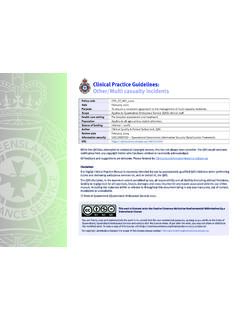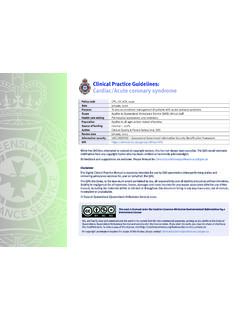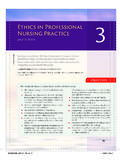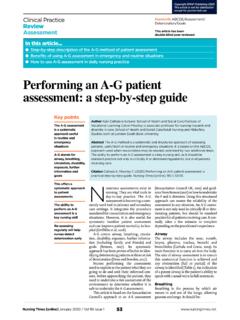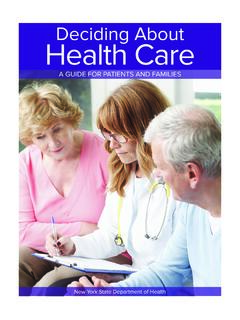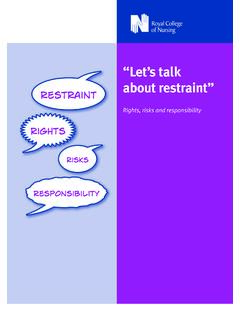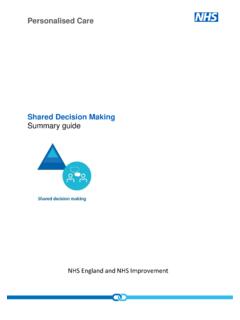Transcription of Clinical Practice Guidelines: Other/Standard cares
1 While the QAS has attempted to contact all copyright owners, this has not always been possible. The QAS would welcome notification from any copyright holder who has been omitted or incorrectly acknowledged. All feedback and suggestions are welcome. Please forward to: The Digital Clinical Practice Manual is expressly intended for use by appropriately qualified QAS clinicians when performing duties and delivering ambulance services for, and on behalf of, the QAS. The QAS disclaims, to the maximum extent permitted by law, all responsibility and all liability (including without limitation, liability in negligence) for all expenses, losses, damages and costs incurred for any reason associated with the use of this manual, including the materials within or referred to throughout this document being in any way inaccurate, out of context, incomplete or unavailable.
2 State of Queensland (Queensland Ambulance Service) work is licensed under the Creative Commons Attribution-NonCommercial-NoDerivatives International LicenseYou are free to copy and communicate the work in its current form for non-commercial purposes, as long as you attribute the State of Queensland, Queensland Ambulance Service and comply with the licence terms. If you alter the work, you may not share or distribute the modified work. To view a copy of this license, visit copyright permissions beyond the scope of this license please contact.
3 CodeCPG_OT_STC_0722 DateJuly, 2022 PurposeTo ensure a consistent appproach to the provision of standard to Queensland Ambulance Service (QAS) Clinical care settingPre-hospital assessment and to all ages unless stated of fundingInternal 100%AuthorClinical Quality & Patient Safety Unit, QASR eview dateJuly, 2025 Information securityUNCLASSIFIED Queensland Government Information Security Classification Practice Guidelines: Other/Standard cares 427 QUEENSLAND AMBULANCE SERVICES tandard caresEvery patient requires a measure of assessment and Clinical deliberation to satisfy the clinician s duty of care .
4 All CPG flowcharts within the CPM begin with Standard cares , which refers to the continual gathering of Clinical information, from vital signs and symptoms to a systematic Clinical history and the analysis of this assessmentThe standard QAS patient assessment includes a primary survey, an appropriate secondary survey and a well planned Clinical history, with review and evaluation of all Clinical information. This dynamic assessment should continue until the patient is transported to a suitable medical facility, or no longer requires primary survey is a rapid procedure designed to identify life-threatening conditions that require immediate secondary survey is a comprehensive compilation of Clinical signs and symptoms, measured in combination with pertinent medical history such as discharge summaries and medical alert devices, which is the foundation of a detailed patient examination.
5 Patient assessment is not a singular event, but a continual process that constantly considers and reevaluates Clinical consentInformed consent requires that the patient has a reasonable understanding of the examination, drug or procedure being performed/administered and the presence or absence of any risks. If the patient is unable to provide informed consent, that is, they are unconscious or in extremis, then consent can be assumed provided the examination, drug or procedure is required, conducted appropriately and is within the clinicians scope of consent is required even if the patient does not speak English well, or at all, or has a disability that makes it difficult for them to understand the clinician or make themselves understood.
6 Two resources that clinicians may consider using to facilitate communication with their patients are:The translating and interpreting service refer to CPP Other/Translating and Interpreting service and the QAS Communication Board available in the Resources Section of this , 2022 Figure Prevention and management of pressure injuriesA pressure injury is an area of localised damage to skin and underlying tissue caused by pressure, shear or friction. While pressure injuries are more likely to affect older people and the frail, they can occur in patients of any age or state of health.
7 Pressure injuries can lead to ulcer formation and life-threatening sepsis in the most severe cases.[1]Risk factors include: patients with impaired mobility, including post-surgery. patients who currently have or had a pressureinjury in the past. Age over 65. Reduced sensory perception diabetes,spinal cord injury, multiple sclerosis. Low BMI or obese. Weight loss/poor nutrition. Urinary and faecal incontinence. Underlying medical conditionsthat impair capillary perfusion,such as diabetes orperipheral vasculardisease.
8 Any person who cannotreposition themselves& lower limbs every20 30 minutes. Excessively moist or dry skin. UNCONTROLLED WHEN PRINTED UNCONTROLLED WHEN PRINTED UNCONTROLLED WHEN PRINTED UNCONTROLLED WHEN PRINTED428 QUEENSLAND AMBULANCE SERVICEP atient in sitting position showing body contact points Patient in lying position supine, lateral and prone positions showing body contact points Clinicians should be vigilant to the possibility that their patient may have or be at risk of developing a pressure injury, especially for those patients having multiple risk the majority of patients are generally in our care for a short time.
9 Clinicians need to be cognisant that appropriate pressure injury identification, prevention and management improve the downstream care of the most common sites of pressure injuries are those with bony protrusions that are frequently in contact with surfaces, however, they can occur anywhere on the body. The diagrams below show common sites for pressure injuries.[2] UNCONTROLLED WHEN PRINTED UNCONTROLLED WHEN PRINTED UNCONTROLLED WHEN PRINTED UNCONTROLLED WHEN PRINTED429 Standard caresPressure injuries are most commonly graded into 4 stages of severity plus a fifth category for non-gradable.
10 [3] Skin intact but may be inflamed/red non-blanchable Painful & warm to touch Spongy or firm Superficial pressure injuries can rapidly deteriorate into severe, life threatening deep tissue ulcers in patients who are not managed appropriately. Skin broken, red and painful Blistering, with/without ooze No visible loose dead tissue Tissue may be pale, red, swollen and warm Skin ulcerated, extending to fat layer May or may not be painful White to black in colour, may be dead tissue May have a foul smelling drainage Full thickness ulcer extending to muscle, tendon or bone White to black in colour May be painful if bone is infected Slough or eschar (dead tissue visible)






